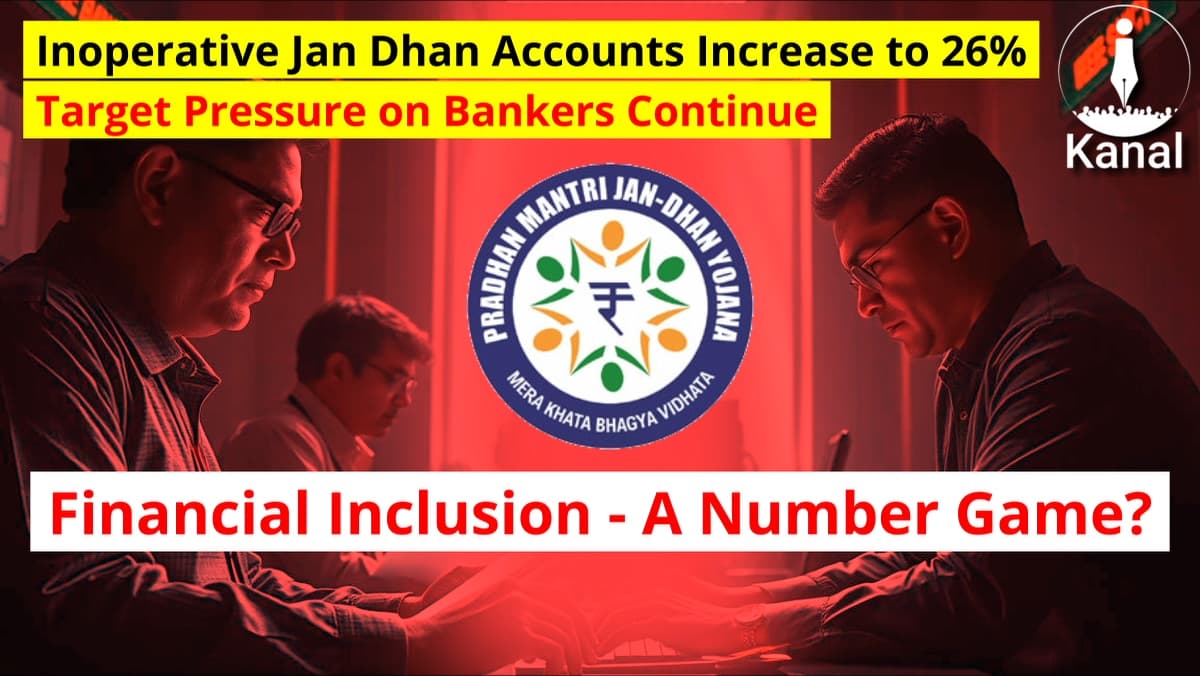Rising Dormant Jan Dhan Accounts and Target Pressure on Bankers: Is Financial Inclusion Just a Numbers Game?
Despite the Union government’s claims of deepening financial inclusion, nearly one-fourth of Jan Dhan accounts in public sector banks have turned inoperative, revealing cracks in the effectiveness of the flagship scheme.

Author: Abhivad
Published: November 7, 2025
While the Union government celebrates over 56 crore Pradhan Mantri Jan-Dhan Yojana (PMJDY) accounts and deposits crossing ₹2.73 lakh crore, new data suggest a less optimistic picture. According to official figures reported by Business Standard, the share of inoperative accounts under the PMJDY has risen from 21% in 2024 to 26% as of September 2025, a worrying sign for a scheme launched to bring India’s unbanked into the formal financial system.
Advertisement
A senior government official cited in the report said that of 554.5 million PMJDY accounts in public sector banks (PSBs), about 142.8 million were inoperative. This means nearly one in every four Jan Dhan accounts has not recorded a single transaction for over a period of two years, the threshold for classifying accounts as dormant as per the Reserve Bank of India(RBI).
Banks See a Steep Rise in Dormancy
Advertisement
Among major public sector banks, Union Bank of India and Bank of India have recorded the highest proportions of inactive accounts at 33% and 32%, respectively. Punjab & Sind Bank reported the lowest share at 8%.
Earlier this year, PSBs collectively closed around 1.5 million zero-balance inoperative accounts as a one-time clean-up drive to eliminate duplicate and non-functional entries. Yet, the growing number of dormant accounts suggests a larger structural issue that extends beyond account duplication.
Advertisement
Ground Reality of ‘Financial Inclusion’
The PMJDY, launched in August 2014, was aimed at providing affordable access to banking, savings, insurance, and credit facilities. However, the current figures point to a disconnect between the policy’s intent and its on-ground execution.
Speaking to Kanal, Prof. R Ramakumar, Professor at the School of Development Studies, Tata Institute of Social Sciences, Mumbai, and Member of the State Planning Board, Kerala, observed that the very definition of financial inclusion has been reduced to mere account ownership.
“The definition of financial inclusion itself has been narrowed down. The only question is whether a person has a bank account or not. The definition does not even consider if the account is operational, let alone questions over credit accessibility,” he said. “Considering the shrinking share of small credits among the total advances of banks over the years, the reality is far from the claims of financial inclusion”, he told Kanal.
Prof. Ramakumar also pointed out that several benefits linked to PMJDY accounts, such as insurance schemes, fail to reach the intended beneficiaries due to a lack of awareness about eligibility conditions.
“Certain insurance policies are linked to each account. Because of unawareness regarding the criteria and eligibility for claims, these benefits do not reach the semi-literate rural peasants and other marginalised sections,” he added.
Operational and Institutional Challenges
Banking unions have repeatedly raised concerns over target pressure to open Jan Dhan accounts and enrol customers in social security schemes. During the Maharashtra Assembly elections in 2024, several reports surfaced alleging coercion and intimidation of bank officials to meet government-set targets. Union leaders claim that such practices not only strain the workforce but also lead to inactive or duplicate accounts created merely to fulfil numerical goals.
According to Devidas Tuljapurkar, General Secretary of the Maharashtra State Bank Employees Federation, the growing inactivity in Jan Dhan accounts is linked to structural issues in the service model itself. He explained that the Banking Correspondents (BC) model, which was meant to extend banking access in rural areas, is collapsing due to low pay, lack of job security, and the presence of exploitative intermediaries. “Many correspondents are opting out, and several frauds are being reported in this model,” he said. Tuljapurkar added that acute staff shortages and various service charges imposed on low-balance accounts further alienate poor customers. “In effect, the process of financial exclusion has already begun,” he warned, urging the government to make the system sustainable.
While the Jan Dhan Yojana remains a landmark initiative in expanding access to banking, the increasing number of dormant accounts challenges the government’s narrative of success. Experts say that unless policies evolve to ensure account activity, awareness, and genuine credit inclusion, India’s financial inclusion story may remain one of quantity over quality.
No comments yet.
